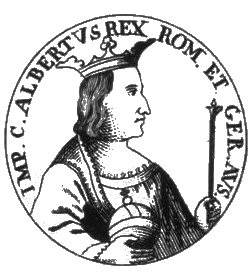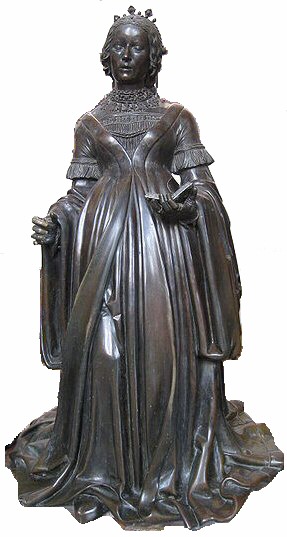On a hill above a loop of the Reuss, just before it flows into the Aare, near the town of Brugg, lies
the monastery Königsfelden.
The foundation of the monastery goes back to a murder. On May 1, 1308, King Albrecht I of Habsburg was stabbed to death in Windisch by his own nephew Johann Parricida for withholding compensation. In his memory his widow Elisabeth had the double monastery Königsfelden (Franciscan and Poor Clares) built. Her daughter Agnes, the early widowed Queen of Hungary, settled here and supported the expansion of the double monastery. Today the Königsfelden monastery church is world-famous for its high Gothic choir windows. The stained glass windows form a unity in content and form and are among the most beautiful of the 14th century. The first burial place for the Habsburgs was built in the church. The murdered King Albrecht I himself was first buried in the Cistercian monastery of Wettingen and later with his father in Speyer.

Former burial place in the church

The burial place for the Habsburg family of Albrecht I. The coffins were later moved to St. Blasien in the Black Forest and then to St. Paul im Lavantal (Carinthia), where they are still found today.
Family tree of the first Habsburgs
Rudolf I
Roman German King 1218 – 1291
Albrecht I
Rudolf II
Albrecht I
röm. dt. König 1255 – 1308
∞ Elisabeth v. Görz-Tirol
Photo of the statue of Elisabeth in Innsbruck at the grave of Maximilian in the Hofkirche
11 children (9 more died at birth), including
Agnes (1280–1364) ∞ Andreas III. von Ungarn († 1301)
Friedrich d. Schöne
röm. dt. König 1289 -1330
Leopold I
Hzg. v. Österreich 1290 – 1326
Albrecht II
Hzg. v. Österreich 1298 – 1358
Otto
Hzg. v. Österreich, Steiermark , Kärnten 1301 - 1339
Rudolf II
Hzg. v. Österreich 1271 – 1290
∞ Agnes v. Böhmen
Johann Parricida*)
Hzg. v. Österr., Steiermark (Mitregent) †1313 (as a prisoner in Pisa)
*) "Parricida" = Patricide, murderer of a blood relative
Commemorative plaque for the noblemen who fell in the Battle of Sempach and fought on the side of the Habsburgs.
The Duke of Austria Leopold III, a grandson of Albrecht I, also died in the battle of 1386.
The knight on the left is Friedrich von Greifenstein from Greifenstein Castle in South Tyrol, the one on the right is Albrecht von Mülinen from Kasteln (Aargau).
The choir windows
The choir windows go back mainly to Elizabeth's daughter Agnes. She looked for sponsors among her siblings. Therefore they were immortalized in the windows.
Detail from the Klara window (1340): Angels playing the harp
Detail of the Anna window from top to bottom: Meeting of Joachim and Anna. Announcement to Joachim and Anna.
Remark: Elizabeth's mother was married in her first marriage to the last Staufer King Conrad IV. When her son Konradin failed in his attempt to reclaim the grandfatherly inheritance of Sicily, he was beheaded in Naples. Thereupon she founded the monastery of Stams. She later married the Count of Tyrol, with whom she had a daughter Elisabeth, who in turn founded Königsfelden.



